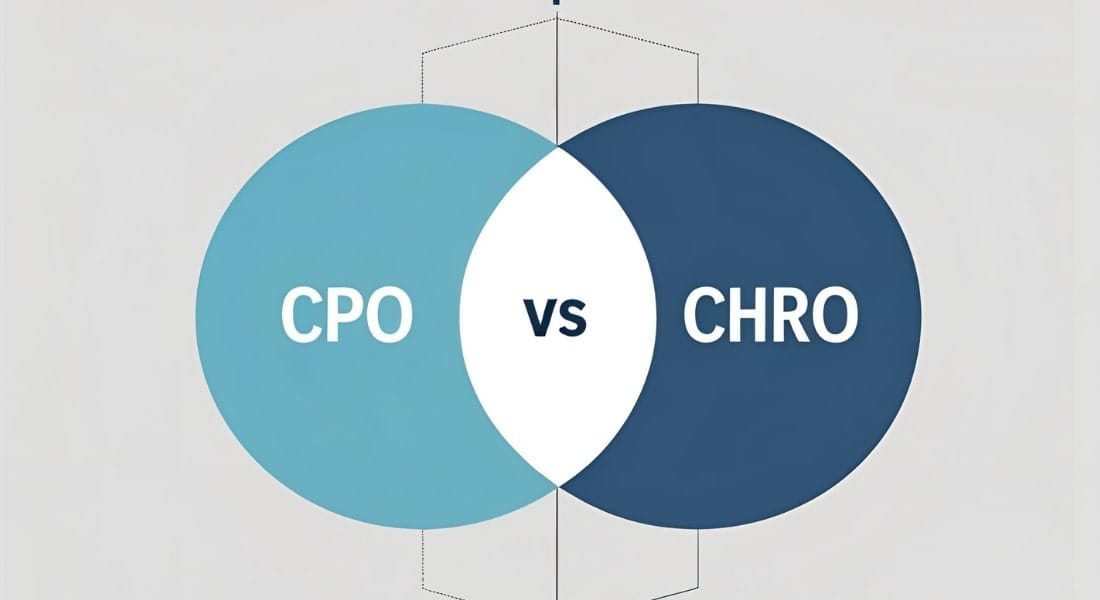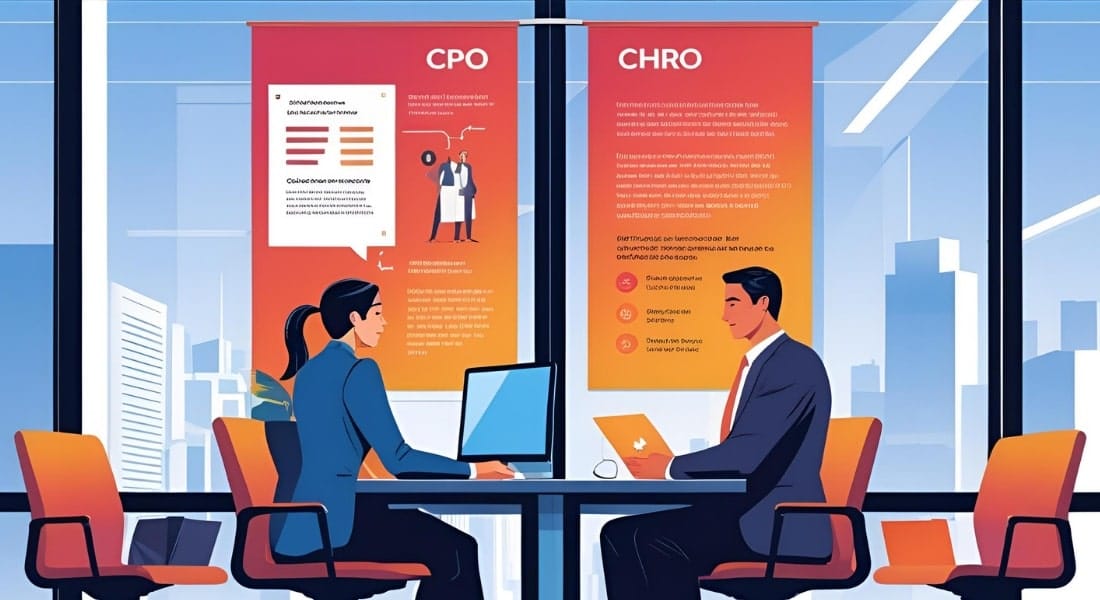Over the past decade, the role of HR has undergone a remarkable transformation. What was once widely viewed as a “cost center” responsible for administrative tasks, payroll, and compliance has evolved into a strategic function capable of driving business outcomes, fostering innovation, and shaping company culture. In this evolving landscape, the titles “Chief People Officer (CPO)” and “Chief Human Resources Officer (CHRO)” are often used interchangeably. However, while both occupy the C-suite and lead the HR function, they represent distinct philosophies and priorities.
The CHRO is traditionally seen as the guardian of human capital, focused on compliance, operations, and risk mitigation. In contrast, the CPO takes a more progressive, strategic approach, emphasizing culture, employee experience, and alignment between people strategy and business goals. This article explores these differences in depth, examining their core philosophies, key responsibilities, and the types of organizations where each role thrives, helping leaders make informed decisions about which HR executive is right for their company.
The Chief Human Resources Officer (CHRO): The Traditionalist and Guardian
Core Philosophy:
The CHRO embodies the mindset of the “guardian” of human capital. Their primary focus is efficiency, compliance, and mitigating risk. The CHRO sees employees as valuable resources to be managed systematically and effectively, ensuring that policies, processes, and organizational structures operate without friction. While still deeply concerned with talent, the CHRO’s approach is methodical and structured, prioritizing stability over experimentation.
Key Responsibilities:
- Compliance and Legal: CHROs ensure the organization adheres to labor laws, safety regulations, and equal employment opportunities. They oversee legal documentation, audits, and regulatory reporting, minimizing the risk of fines or litigation.
- Compensation & Benefits: They manage payroll, health benefits, retirement plans, and other total rewards programs, balancing competitiveness with financial prudence.
- Employee Relations: CHROs handle grievances, disputes, and disciplinary matters, ensuring policies are applied consistently and fairly across the organization.
- HR Operations: From HRIS management to administrative oversight, CHROs maintain the infrastructure that keeps HR running smoothly, often leading teams of HR generalists or administrators.
- Talent Management: They oversee structured programs for performance reviews, succession planning, and training. While strategic, this responsibility emphasizes consistency and repeatability rather than dynamic innovation.
Ideal for Companies:
The CHRO is particularly well-suited to large, mature organizations where stability, compliance, and risk mitigation are critical. Examples include publicly-traded corporations, financial institutions, insurance companies, or government agencies. In these environments, the CHRO ensures that policies, procedures, and operations function efficiently, maintaining a reliable and legally compliant HR foundation. While the role may appear more conservative, its value in avoiding risk and ensuring operational excellence is substantial.
The Chief People Officer (CPO): The Innovator and Culture Architect

Core Philosophy:
The CPO, in contrast, is the “architect” of the organization’s people strategy. Rather than viewing employees primarily as resources to be managed, the CPO emphasizes the individual experience and the collective impact of culture on business outcomes. This role is driven by empathy, innovation, and the understanding that a thriving workforce directly contributes to revenue, customer satisfaction, and competitive advantage.
Key Responsibilities:
- Employee Experience & Culture: The CPO designs and nurtures a company culture that attracts, engages, and retains top talent. From onboarding to internal communications, recognition programs, and well-being initiatives, they ensure every touchpoint enhances the employee experience.
- Talent Strategy & Development: They focus on proactive workforce planning, identifying skill gaps, and building internal career mobility programs. Unlike the CHRO’s structured succession planning, the CPO promotes dynamic growth opportunities for all employees.
- Organizational Design & Change Management: Partnering with the CEO and C-suite, the CPO shapes organizational structures to be agile and scalable. They lead people-focused aspects of mergers, acquisitions, and other transformative initiatives.
- Diversity, Equity, & Inclusion (DEI): DEI is often a strategic priority for CPOs, considered essential for innovation, engagement, and long-term competitiveness.
- Strategic Business Partnership: The CPO advises the executive team on how people strategy can drive revenue, improve customer outcomes, and enhance organizational performance, integrating HR into broader business objectives.
Ideal for Companies:
CPOs thrive in high-growth environments, startups, and technology companies where culture, agility, and employee engagement are central to success. Organizations that see their workforce as a core competitive advantage benefit from a CPO’s visionary approach, as they bridge HR strategy with business strategy. In such contexts, the CPO ensures that people practices scale alongside rapid growth and that culture remains a source of strength rather than a casualty of expansion.
The Venn Diagram of Overlap and Distinction
While both CHROs and CPOs are executive leaders responsible for human capital, there are clear distinctions in their priorities and approaches:
Overlap:
- Both report directly to the CEO and occupy C-suite roles.
- Both are accountable for talent management, compensation, and employee relations.
- Both influence organizational performance through HR strategy and execution.
CHRO Distinction:
- Focuses on compliance, risk mitigation, and operational efficiency.
- Emphasizes structured programs, HR policies, and process standardization.
- Ideal for large, established, and heavily regulated organizations.
CPO Distinction:
- Prioritizes culture, employee experience, and business-aligned people strategy.
- Acts as a strategic partner to the executive team on growth, innovation, and talent mobility.
- Ideal for high-growth, technology-driven, or people-centric companies seeking to leverage culture as a competitive advantage.

Conclusion
The distinction between a CPO and a CHRO is more than semantics—it reflects a company’s philosophy, stage of growth, and strategic priorities. A CHRO excels in environments where structure, compliance, and risk mitigation are paramount, providing operational rigor and safeguarding human capital. The CPO, meanwhile, represents a forward-looking, progressive approach, using culture, employee experience, and strategic talent initiatives to drive business outcomes.
For founders and executives, understanding this distinction is critical. Choosing the right HR executive is not about adopting a trendy title; it is about aligning the role with your company’s vision and competitive strategy. While the CHRO remains vital in many contexts, the rise of the CPO underscores the modern recognition that people strategy is no longer a support function—it is a key engine of growth, innovation, and long-term success. For companies that view their workforce as their most valuable asset, the CPO is poised to become the new standard in the C-suite.


